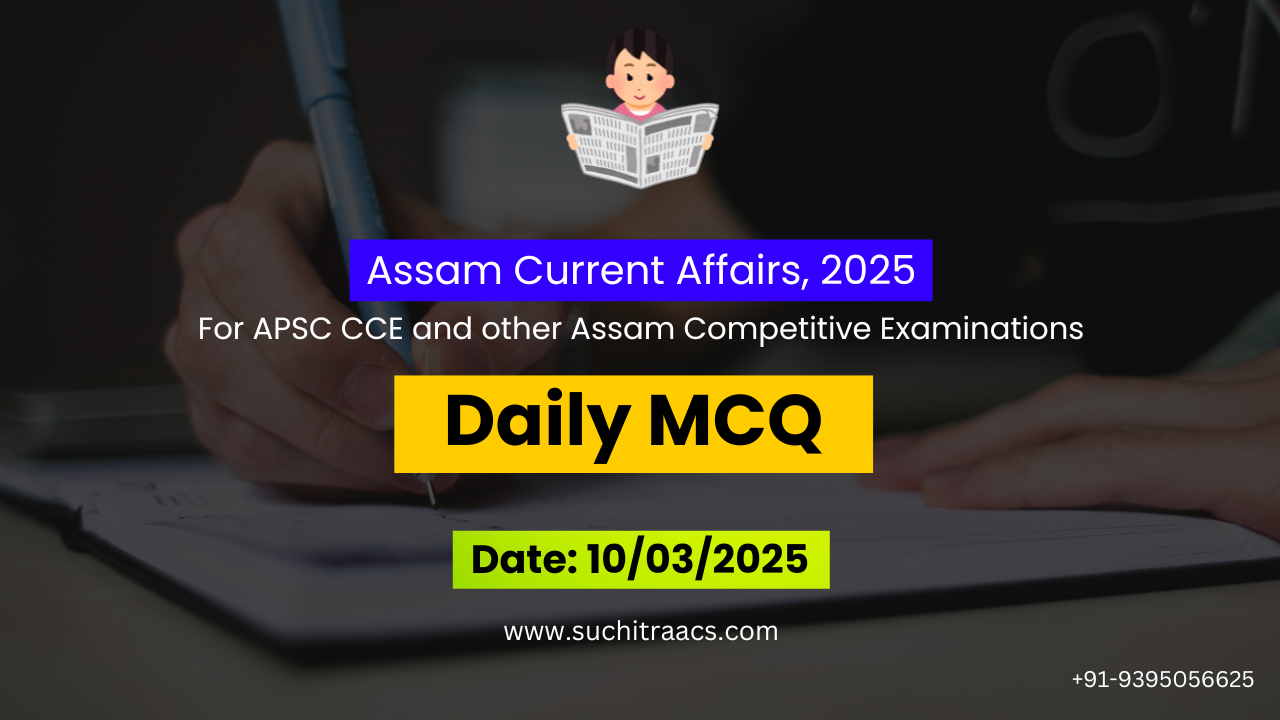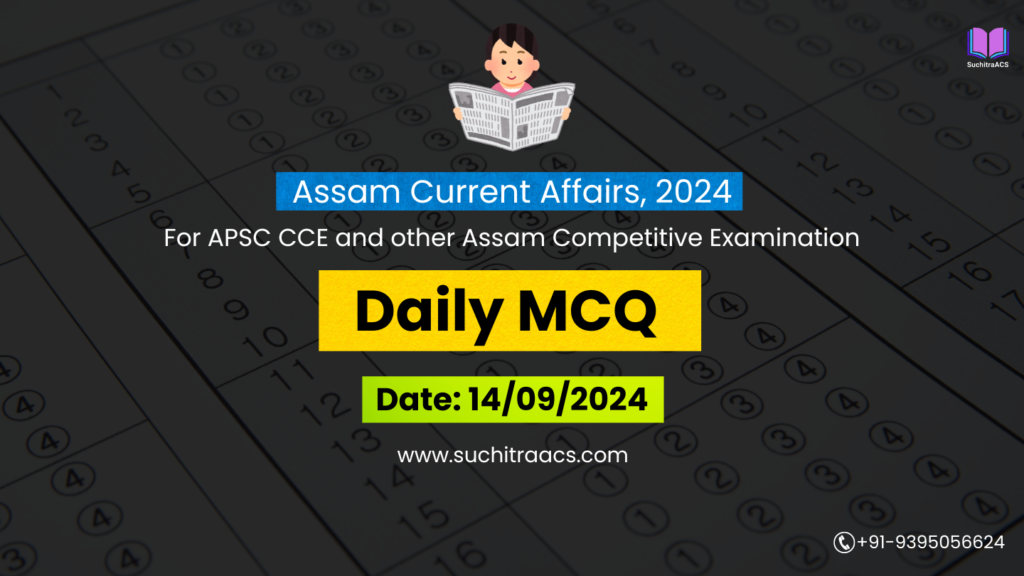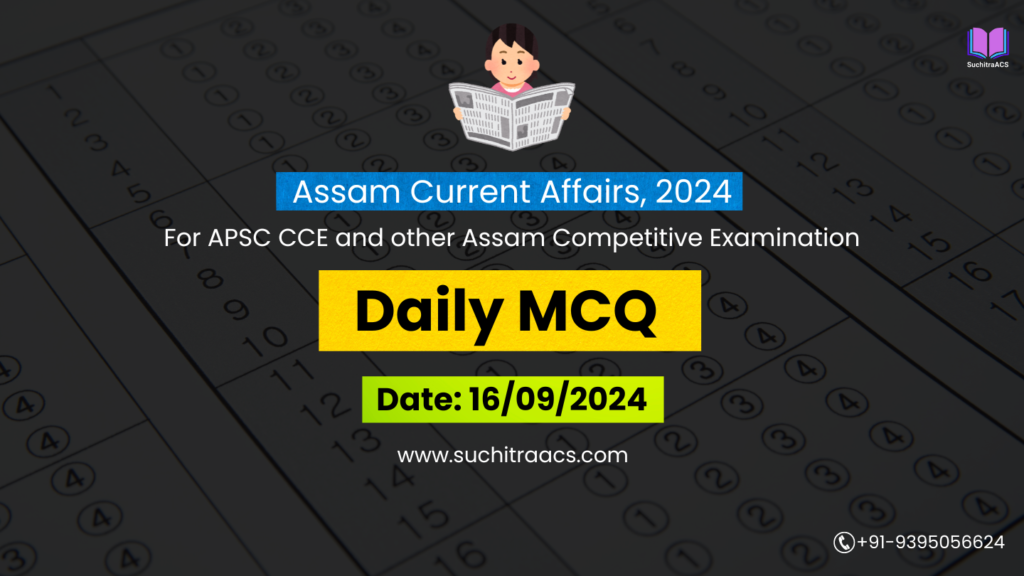APSC MCQs / APSC Prelims Practice Questions based on Assam Tribune (Daily) – 10/03/2025
For APSC CCE and other Assam Competitive examinations aspirants, practicing Daily MCQs is vital. This blog covers most important Prelims questions from the Assam Tribune today (10-03-2025). These issues are key for both APSC Prelims syllabus, offering insights into the important topics of current affairs.
APSC MCQs / APSC Prelims Practice Questions (Date: 10/03/2025)
Topic 1: Illegal Sand Mining Killing Kulsi River
Question 1
Which of the following environmental issues are associated with illegal sand mining?
- Groundwater depletion
- Riverbank erosion
- Disruption of aquatic biodiversity
- Desertification
Select the correct answer using the code below:
a) 1 and 2 only
b) 2 and 3 only
c) 1, 2, and 3 only
d) 1, 2, 3, and 4
✅ Answer: c) 1, 2, and 3 only
Explanation:
- Groundwater depletion: Sand acts as a natural filter for groundwater recharge. Excessive mining disrupts this process.
- Riverbank erosion: Removal of sand weakens riverbanks, making them prone to collapse.
- Disruption of aquatic biodiversity: Destroys fish habitats and endangers species like the Gangetic Dolphin.
- Desertification is not directly caused by sand mining, but by deforestation and land degradation.
Question 2
Which of the following laws regulate sand mining in India?
- The Mines and Minerals (Development and Regulation) Act, 1957
- The Environment Protection Act, 1986
- The Wildlife Protection Act, 1972
- The Coastal Regulation Zone (CRZ) Notification, 2011
Select the correct answer using the code below:
a) 1 and 2 only
b) 1, 2, and 3 only
c) 1, 2, and 4 only
d) 1, 2, 3, and 4
✅ Answer: d) 1, 2, 3, and 4
Explanation:
- Mines and Minerals (Development and Regulation) Act, 1957: Regulates mineral extraction, including sand mining.
- Environment Protection Act, 1986: Mandates environmental impact assessments (EIA) for mining activities.
- Wildlife Protection Act, 1972: Protects species like Gangetic Dolphins, which are affected by mining.
- CRZ Notification, 2011: Regulates sand mining in coastal and estuarine areas.
Topic 2: 100% Rail Network Electrification in Assam by 2025 End
Question 3
Which of the following are expected benefits of railway electrification?
- Reduction in carbon emissions
- Faster train speeds and better efficiency
- Lower operational costs for Indian Railways
- Decrease in railway passenger fares
Select the correct answer using the code below:
a) 1 and 2 only
b) 1, 2, and 3 only
c) 1, 2, 3, and 4
d) 2 and 4 only
✅ Answer: c) 1, 2, 3, and 4
Explanation:
- Railway electrification reduces carbon emissions by shifting from diesel to electric locomotives.
- Electrified trains run at higher speeds, improving railway efficiency.
- Electric trains are cheaper to operate, reducing maintenance and fuel costs.
- Lower costs may lead to reduced fares, but this depends on government policy.
Question 4
Which of the following initiatives aim to make Indian Railways environmentally sustainable?
- Mission 100% Electrification
- Net Zero Railway Target (2030)
- Dedicated Freight Corridor (DFC)
- Hydrogen Train Project
Select the correct answer using the code below:
a) 1 and 2 only
b) 1, 2, and 3 only
c) 1, 2, and 4 only
d) 1, 2, 3, and 4
✅ Answer: d) 1, 2, 3, and 4
Explanation:
- Mission 100% Electrification: Goal to electrify all broad-gauge railway lines by 2030.
- Net Zero Railway Target (2030): Indian Railways aims to become carbon neutral by 2030.
- Dedicated Freight Corridor (DFC): Uses electrified tracks for high-speed cargo transport.
- Hydrogen Train Project: Develops hydrogen-powered trains as an alternative to diesel.
Topic 3: AASU Demands Special Drive to Detect and Deport Illegal Migrants
Question 5
Which of the following provisions relate to the detection and deportation of illegal migrants in Assam?
- National Register of Citizens (NRC)
- Assam Accord (1985)
- Citizenship Amendment Act (CAA), 2019
- Foreigners Act, 1946
Select the correct answer using the code below:
a) 1 and 2 only
b) 1, 2, and 4 only
c) 2 and 3 only
d) 1, 2, 3, and 4
✅ Answer: d) 1, 2, 3, and 4
Explanation:
- NRC: Aims to identify legal citizens and detect illegal migrants in Assam.
- Assam Accord (1985): Agreed to detect and deport foreigners who entered Assam after March 24, 1971.
- CAA (2019): Grants citizenship to persecuted minorities but excludes Muslims, creating debate over its impact on Assam’s migration issue.
- Foreigners Act, 1946: Allows the government to identify and deport illegal immigrants.
Question 6
Which of the following measures are part of India’s border security strategy with Bangladesh?
- Border Fencing Project
- Smart Border Surveillance System
- Indo-Bangladesh Border Treaty (2015)
- SAARC Anti-Terrorism Framework
Select the correct answer using the code below:
a) 1 and 2 only
b) 1, 2, and 3 only
c) 2 and 4 only
d) 1, 2, 3, and 4
✅ Answer: b) 1, 2, and 3 only
Explanation:
- Border Fencing Project: Aims to seal the India-Bangladesh border to prevent illegal migration.
- Smart Border Surveillance System: Uses drones, sensors, and CCTV cameras for real-time monitoring.
- Indo-Bangladesh Border Treaty (2015): Resolved land boundary disputes and improved border security cooperation.
- SAARC Anti-Terrorism Framework focuses on counterterrorism, not border security.
Topic 4: Cabinet Nod to Act on Coaching Institutes
Question 7
Which of the following issues are associated with unregulated coaching institutes in India?
- High fees and lack of affordability
- Misleading success rate advertisements
- Excessive academic pressure on students
- Lack of quality control over faculty hiring
Select the correct answer using the code below:
a) 1 and 2 only
b) 1, 2, and 3 only
c) 1, 2, 3, and 4
d) 2 and 4 only
✅ Answer: c) 1, 2, 3, and 4
Explanation:
- Unregulated coaching centers charge exorbitant fees, making access to quality education unequal.
- Misleading advertisements falsely claim high success rates to attract students.
- Excessive workload causes stress, anxiety, and depression among students.
- Many coaching institutes employ unqualified teachers, lacking a standardized faculty selection process.
Question 8
Which laws in India help regulate private coaching institutes and protect students’ rights?
- National Education Policy (NEP) 2020
- Consumer Protection Act, 2019
- Right to Education (RTE) Act, 2009
- The Competition Act, 2002
Select the correct answer using the code below:
a) 1 and 2 only
b) 1, 2, and 3 only
c) 2 and 4 only
d) 1, 2, 3, and 4
✅ Answer: b) 1, 2, and 3 only
Explanation:
Competition Act deals with market monopoly, not education regulation.
NEP 2020 promotes school education reforms, reducing dependence on coaching.
Consumer Protection Act protects students from misleading advertisements.
RTE Act ensures access to affordable education, indirectly influencing coaching regulations.
 APSC Prelims Crash Course, 2025
APSC Prelims Crash Course, 2025
at most affordable rate in Assam!

🔔 Join Our WhatsApp Study Group!
For exclusive access to premium quality content, including study materials, current affairs, MCQs, and model answers for APSC CCE and other Assam competitive exams.
Click here to join: SuchitraACS Study WhatsApp Group
📚 Want to know more about SuchitraACS’s most affordable courses?
Click here to know more: SuchitraACS Courses for APSC CCE and Assam Competitive Examinations




